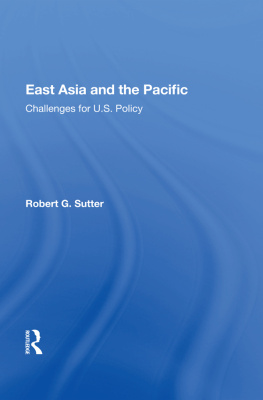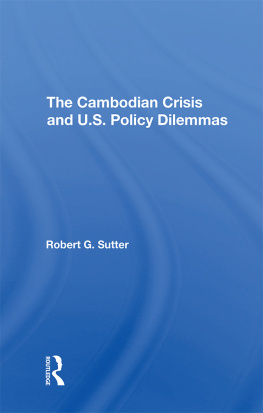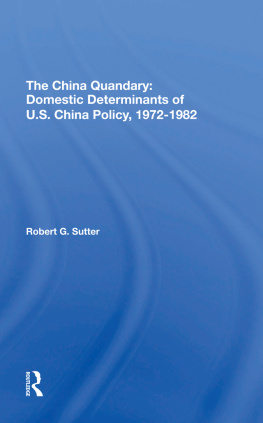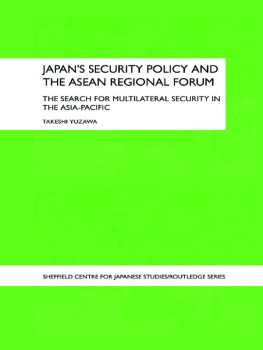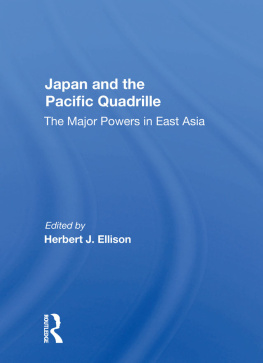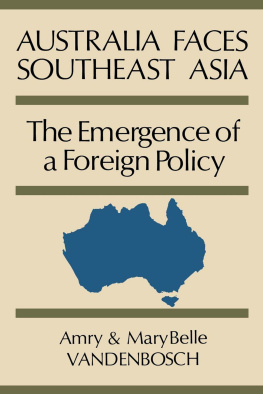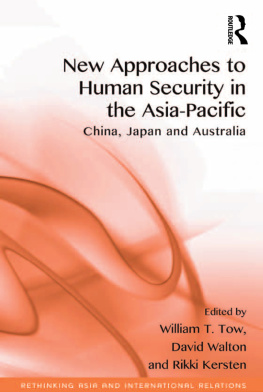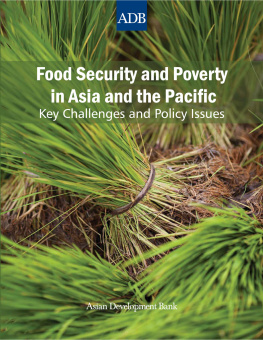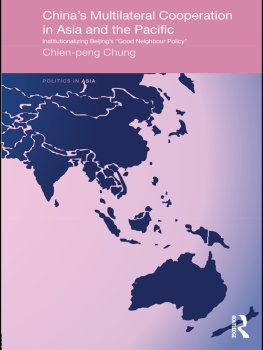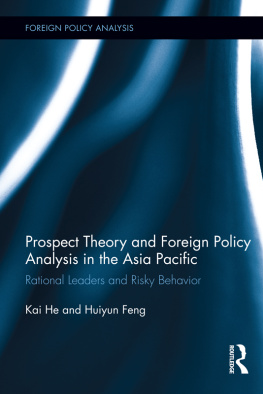First published 1992 by Westview Press
Published 2018 by Routledge
52 Vanderbilt Avenue, New York, NY 10017
2 Park Square, Milton Park, Abingdon, Oxon OX14 4RN
Routledge is an imprint of the Taylor & Francis Group, an informa business
Copyright 1992 by Taylor & Francis
All rights reserved. No part of this book may be reprinted or reproduced or utilised in any form or by any electronic, mechanical, or other means, now known or hereafter invented, including photocopying and recording, or in any information storage or retrieval system, without permission in writing fromthe publishers.
Notice:
Product or corporate names may be trademarks or registered trademarks, and are used only for identification and explanation without intent to infringe.
Library of Congress Cataloging-in-Publication Data
Sutter, Robert G.
East Asia and the Pacific : challenges for U.S. policy / Robert G.
Sutter with a contribution by Larry Niksch.
p. cm.
Includes bibliographical references (p. ) and index.
ISBN 0-8133-1370-8
1. East AsiaRelationsUnited States. 2. United States
RelationsEast Asia. 3. Asia, SoutheasternRelationsUnited
States. 4. United StatesRelationsAsia, Southeastern.
5. Pacific AreaRelationsUnited States. 6. United States
RelationsPacific Area. I. Title.
DS518.8.S88 1992
327. 7305dc20
92-15868
CIP
ISBN 13: 978-0-367-00441-5 (hbk)
Introduction and Overview
It was commonplace in late 1991 to state that Americas role in East Asia and the Pacific was in transition. Indeed, it is widely known that the underpinnings of past U.S. policy in Asia and the Pacific, as in other parts of the world, are subject to significant change. The strangely reassuring bipolarity of the Cold War world has given way increasingly to a much less well structured new world order, where sometimes conflicting trends of economic competition, military instability, and political turmoil intersect and complicate U.S. foreign policymaking.
Few argue anymore that the United States can pull away from Asia and the Pacific. Our economies have become increasingly intertwined; U.S. economic well-being is increasingly dependent on foreign economic interchange. Asia has half of the top ten U.S. trading partners. In 1990, Japan had $65 billion in direct investment in the United States, and the United States had more than $17 billion invested in Japan. Some $100 billion in U.S. government securities held by Japanese helped to finance a substantial portion of the U.S. budget deficit.
Much has been made of U.S. leadership in the multinational alliance opposed to Iraqs invasion of Kuwait; but U.S. leaders are among the first to acknowledge the importance of Japans financial contribution in this effort. China also was important in the Gulf crisis because it held crucial veto power in the U.N. Security Council. Both Asian states have significant roles to play in the postwar situation in the Gulf, as the United States labors to help restore order, rebuild destroyed economies, and establish arms limitation and technology transfer regimes designed to foster regional peace and stability.
Meanwhile, the steady increase of Asian-American personal, cultural, and other interaction has grown to a level that affects all major aspects of American society. Large-scale Asian immigration to the United States since the 1960s has made Asian-American communities important social, economic, and political forces in most American states and in national affairs. Students from Asian countries represent the largest group of foreign students seeking advanced training and greater intellectual opportunity in the United States. Travel to Asia for business, education, and tourism has been a steadily growing feature of American life.
In the wake of World War II, it was clear that the United States played the dominant role in Asia and the Pacific. It shouldered the leading security role, nurtured the economies of allied and associated states, and fostered, to some degree, greater political pluralism. For several decades, the United States relied on its dominant military and economic power in order to achieve U.S. goals and to secure U.S. interests in the region. By late 1991, that situation had changed, posing new challenges for U.S. policy. This change is the result of several factors, including the following:
- The East Asian countries are increasingly powerful economically, exert greater political influence in Asian and world affairs, and to some extent register greater importance in world military affairs.
- The decline in the Soviet threat due to the collapse of the Soviet Union and the elimination of the related threat of communist infiltration/insurgency means that many East Asian countries that had looked to the United States as a security guarantor have less obvious incentive to seek U.S. support.
- The U.S. government has less economic power at its disposal for Asia and the Pacific. Budget constraints sharply limit the U.S. military presence and foreign assistance levels. There are competing U.S. budget priorities coming especially from the instability in the Middle East and in Eastern Europe and the Soviet republics. U.S. leaders also are concerned to focus resources on domestic needs in order to remain a leader in what is seen as a highly competitive international economic environment.
- The U.S. private sector also has limited resources. It must focus on domestic priorities as well as seek foreign opportunities in an increasingly economically competitive and interdependent world.
Thus, at present, the United States can no longer play the dominant role in the East Asia-Pacific region as it did in the past. Indeed, playing such a dominant role had sometimes led to costly mistakes, notably the protracted U.S. conflict in Indochina. The United States cant afford costly policy mistakes, and yet the United States needs to remain involved in order to preserve important interests. In this context, American leaders would appear to need to use U.S. resourcespolitical, economic, military, and culturalas effectively as possible. American policymakers, backed by informed public opinion, will need to have the knowledge and the ability to decide when and how to accommodate, confront, or otherwise deal with East Asian-Pacific countries and trends that affect important U.S. interests and policy goals. To assist the formation of effective U.S. policy, American leaders and the general public need to think about the answers to such questions as: What are U.S. interests in the current East Asian-Pacific environment? In what direction does the United States want to encourage development in the region and what are its goals? and What strategies can the U.S. government use to achieve those goals?
When looking at broad trends in U.S. interaction with Asia, analysts see three overarching goals. First, the United States has remained concerned with maintaining a balance of power in the region that is favorable to American interests. This concern implies that U.S. policy continues to oppose efforts at domination of the region by a power or group of powers hostile to the United States. Second, the United States has endeavored to advance its economic interests in the region through involvement in economic development and expanded U.S. trade and investment. A third major goal, centered on American culture and values, has involved efforts to foster democracy, human rights, and other trends deemed culturally progressive by Americans.
The degree of emphasis placed on these goals by U.S. leaders has varied over time, as has the ability of U.S. leaders to set priorities and organize objectives as part of a coherent national approach serving the interests of the United States. Historians remind us that the roots of American policy in Asia go well back in time. In the next chapter, a review of the highlights of U.S. policy toward the region shows deeply rooted but often poorly defined policy interests. During much of the nineteenth century, informal economic and cultural activities (e.g., trade, tourism, and missionary endeavors) were the main elements of U.S. relations with East Asia and the Pacific. There were few formal geopolitical arrangements. The Spanish-American War, U.S. naval expansion, and the acquisition of Pacific possessions changed this situation. American economic and military power grew; the United States became a major world actor by the time of World War I. The American experience in Asia at that time was as much military and economic as it was cultural. But there still was little sense of order among the various aspects of American-Asian relations. The United States supported the balance of power in the region and promoted trade and political reform movements, but failed to establish precedence for one set of goals over another or to show how these respective goals reinforced each other.

